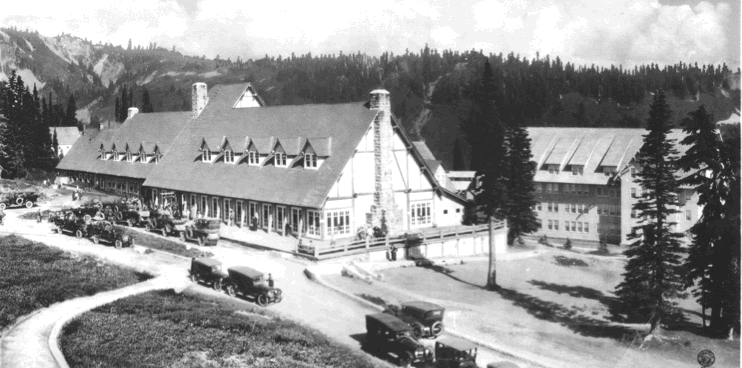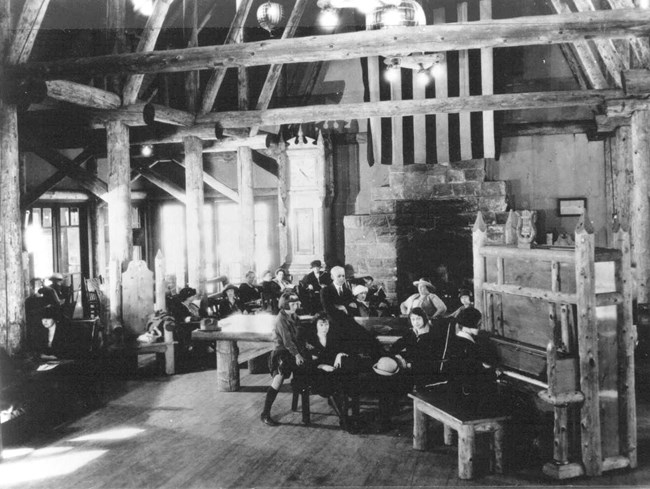Last updated: August 1, 2023
Article
Paradise Inn: A History of Beauty and Challenge

NPS Photo
Construction of the Paradise Inn began the summer of 1916. Ground was broken on July 20, and most of the lobby, dining room, and rooms above the dining room, were completed that first summer. Designed by Heath, Grove, and Bell with a large open timber frame, workers received permission to harvest dead Alaska yellow cedars a few miles down the road. A wildfire almost twenty years before had killed the trees but left them standing. Construction finished the following summer costing $91,000.

NPS Photo
Opening on July 1, 1917, the inn had thirty-seven guest rooms and a dining room that could accommodate 400. Distinctive furnishing made by Hans Fraehnke enhanced the lobby, including woodwork of the registration desk, two massive cedar tables and chairs, a mail drop “stump”, and cases for the 14 foot tall clock and the piano. Originally, the lobby was lit by Japanese lanterns. These were probably replaced during a 1930s remodel when can-shaped parchment lanterns appeared, painted with different types of native plants.
The Mount Rainier Park Company planned on adding more guest rooms over time but the lack of visitors during World War I slowed their agenda. The long, snowy winters at Paradise also held them back, requiring that they close the inn each autumn for more than half the year. By 1920, enough guests were staying at the lodge that the company could start building again. Completed by the end of the year, the Paradise Inn Annex more than doubled the size of the inn, providing 104 more guest rooms.

NPS/Bullard Photo
The 1920s brought challenges for the Paradise Inn. The Great Depression rapidly decreased the number of people traveling to Paradise and the few that did come tended to camp or only visit for the day. The long winters also started posing challenges as the many feet of snow piled up against the building, slowly pushing it downhill. Structural braces were added to the timbers to help resist this extra stress every winter.
The end of the Great Depression and the victory of World War II failed to bring back guests to the Paradise Inn. The automobile changed how people visited Paradise. More and more, folks only came for the day and went back to town each evening. By the 1950s, the Mount Rainier Park Company couldn’t make a profit and sold the building to the National Park Service. The NPS began leasing the building to companies to run as a concession.

NPS Photo
The years and the extreme weather at Paradise were not kind to the Inn and maintenance needs piled up with little money to pay to fix them. Small projects were worked on over the decades but larger projects took time. 1980-81 brought a $2.8 million renovation for structural stabilization. From 2006 to 2008, another rehabilitation ensured the Inn’s lobby and dining room stood on a solid foundation and could withstand earthquakes better. Rehabilitation of the Annex and snow bridge was completed from 2017 through 2018 to assure the strength and safety of that part of the building as well. With this work, the National Park Service hopes that future visitors will continue to see and enjoy the historic, rustic beauty of the Paradise Inn.
Learn more about the services, attractions and hiking trails available at Paradise.
Additional Articles about Paradise:
Wonderland: An Administrative History of Mount Rainier National Park by Theodore Catton.
The Rustic Furnishings of Mount Rainier National Park 1916-1996.
